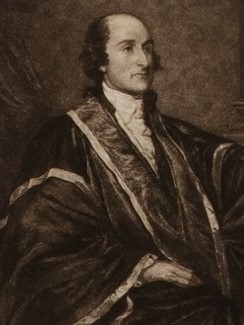
By Jim O’Neal
John Adams had the misfortune of being squeezed into the presidency of the United States (for a single term) between George Washington and Thomas Jefferson, two of the most famous presidents of all time. As a result, Adams (1735-1826) was often overlooked as one of America’s greatest statesmen and perhaps the most learned and penetrating thinker of his time. The importance of his role in the founding of America was noted by Richard Stockton, a delegate to the Continental Congress: “The man to whom the country is most indebted for the great measure of independence. … I call him the Atlas of American Independence.”
On the way to that independence, his participation started as early as 1761 when he assisted James Otis in defending Boston merchants against Britain’s enforcement of the Sugar Tax. When the American Revolution ended, Adams played a key role in the peace treaty that formally ended the war in 1783. In between those two bookends, he wrote many of the most significant essays and treatises, led the radical movement in Boston, and articulated the principles at the Continental Congress.
Following the infamous Stamp Act in 1765, he attacked it with a vengeance and wrote A Dissertation on the Canon and Feudal Law, asserting it deprived the colonists of two basic rights: taxation by consent and a jury trial by peers – both guaranteed to all Englishmen by the Magna Carta. Within a brief 10 years, he was acknowledged as one of America’s best constitutional scholars. When Parliament passed the Coercive Acts in 1774, Adams drafted the principal clause of the Declaration of Rights and Grievances; no man worked harder in the movement for independence and the effort to constitutionalize the powers of self-government.
After the Battles of Lexington and Concord, Adams argued for the colonies to declare independence and in 1776, Congress passed a resolution recommending the colonies draft new constitutions and form new governments. Adams wrote a draft blueprint, Thoughts on Government, and four states used it to shape new constitutions. In summer 1776, Congress considered arguments for a formal independence and John Adams made a four-hour speech that forcefully persuaded the assembly to vote in favor. Thomas Jefferson later recalled that “it moved us from our seats … He was our colossus on the floor.”
Three years later, Adams drafted the Massachusetts Constitution, which was copied by other states and guided the framers of the Federal Constitution of 1787.
He faithfully served two full terms as vice president for George Washington at a time when the office had only two primary duties: preside over the Senate and break any tie votes, and count the ballots for presidential elections. Many routinely considered the office to be part of Congress as opposed to the executive branch. He served one term as president and then lost the 1800 election to his vice president, Thomas Jefferson, as the party system (and Alexander Hamilton) conspired against his re-election. Bitter and disgruntled, he left Washington, D.C., before Jefferson was inaugurated and returned to his home in Massachusetts. His wife Abigail had departed earlier as their son Charles died in November from the effects of chronic alcoholism.
Their eldest son, John Quincy Adams, served as the sixth president (for a single term) after a contentious election, and they both gradually sunk into relative obscurity. This changed dramatically in 2001 when historian David McCullough published a wonderful biography that reintroduced John and Abigail Adams to a generation that vaguely knew he had died on the same day as Thomas Jefferson, July 4, 1826 – the 50th anniversary of the signing of the Declaration of Independence. In typical McCullough fashion, it was a bestseller and led to an epic TV mini-series that snagged four Golden Globes and a record 13 Emmys in 2008.
Television at its very best!
 Intelligent Collector blogger JIM O’NEAL is an avid collector and history buff. He is president and CEO of Frito-Lay International [retired] and earlier served as chair and CEO of PepsiCo Restaurants International [KFC Pizza Hut and Taco Bell].
Intelligent Collector blogger JIM O’NEAL is an avid collector and history buff. He is president and CEO of Frito-Lay International [retired] and earlier served as chair and CEO of PepsiCo Restaurants International [KFC Pizza Hut and Taco Bell].


